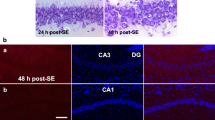Abstract
Glycogen synthase kinase 3β (GSK3β) is believed to play important roles in the regulation of synaptic plasticity, cell survival and circadian rhythms in the mature CNS. However, although several studies have been focused on the GSK3β, little is known about GSK3β changes in glial cells under neuropathological conditions. In this study, we evaluated the expressions of molecules associated with the GSK3β signaling pathway, following the induction of an excitotoxic lesion in mouse brain by kainic acid (KA) injection, which caused pyramidal cell degeneration in the hippocampal CA3 region. In injured hippocampi, Ser47-Akt (protein kinase B, PKB) phosphorylation increased from 4 h until 1 day post-injection (PI). Ser9-GSK3β and Ser133-cAMP responsive element-binding protein (CREB) phosphorylations showed similar spatiotemporal patterns in hippocampi at 1 day until 3 days PI. Double immunohistochemistry also showed that these phosphorylated forms of Akt, GSK3β and CREB were expressed in astrocytes. For the first time, our data demonstrate the injury-induced astrocytic changes in the levels of phosphorylation of Akt, -GSK3β and -CREB in vivo, which may reflect mechanisms of glial cells protection or adaptive response to damage.







Similar content being viewed by others
References
Grimes CA, Jope RS (2001b) The multifaceted roles of glycogen synthase kinase 3beta in cellular signaling. Prog Neurobiol 65(4):391–426
Beurel E, Jope RS (2006) The paradoxical pro- and anti-apoptotic actions of GSK3 in the intrinsic and extrinsic apoptosis signaling pathways. Prog Neurobiol 79(4):173–189
Nonaka S, Hough CJ, Chuang DM (1998) Chronic lithium treatment robustly protects neurons in the central nervous system against excitotoxicity by inhibiting N-methyl-d-aspartate receptor-mediated calcium influx. Proc Natl Acad Sci USA 95:2642–2647
Woodgett JR (2003) Physiological roles of glycogen synthase kinase-3: potential as a therapeutic target for diabetes and other disorders. Curr Drug Targets Immune Endocr Metabol Disord 3(4):281–290
Dou H, Ellison B, Bradley J, Kasiyanov A, Poluektova LY, Xiong H, Maggirwar S, Dewhurst S, Gelbard HA, Gendelman HE (2005) Neuroprotective mechanisms of lithium in murine human immunodeficiency virus-1 encephalitis. J Neurosci 25:8375–8385
Takashima A, Noguchi K, Sato K, Hoshino T, Imahori K (1993) Tau protein kinase I is essential for amyloid beta-protein-induced neurotoxicity. Proc Natl Acad Sci USA 90:7789–7793
Pap M, Cooper GM (1998) Role of glycogen synthase kinase-3 in the phosphatidylinositol 3-Kinase/Akt cell survival pathway. J Biol Chem 273:19929–19932
Sanchez JF, Sniderhan LF, Williamson AL, Fan S, Chakraborty-Sett S, Maggirwar SB (2003) Glycogen synthase kinase 3beta-mediated apoptosis of primary cortical astrocytes involves inhibition of nuclear factor kappaB signaling. Mol Cell Biol 23:4649–4662
Nadler JV, Perry BW, Gentry C, Cotman CW (1980) Degeneration of hippocampal CA3 pyramidal cells induced by intraventricular kainic acid. J Comp Neurol 192:333–359
Mitchell J, Sundstrom LE, Wheal HV (1993) Microglial and astrocytic cell responses in the rat hippocampus after an intracerebroventricular kainic acid injection. Exp Neurol 121:224–230
Zhang L, Ong WY, Lee T (1999) Induction of P-glycoprotein expression in astrocytes following intracerebroventricular kainate injections. Exp Brain Res 126:509–516
Walton MR, Dragunow I (2000) Is CREB a key to neuronal survival? Trends Neurosci 23:48–53
Ji L, Mochon E, Arcinas M, Boxer LM (1996) CREB proteins function as positive regulators of the translocated bcl-2 allele in t(14;18) lymphomas. J Biol Chem 271:22687–22691
Riccio A, Ahn S, Davenport CM, Blendy JA, Ginty DD (1999) Mediation by a CREB family transcription factor of NGF-dependent survival of sympathetic neurons. Science 286(5448):2358–2361
Grimes CA, Jope RS (2001a) CREB DNA binding activity is inhibited by glycogen synthase kinase-3 beta and facilitated by lithium. J Neurochem 78:1219–1232
Laursen SE, Belknap JK (1986) Intracerebroventricular injections in mice. Some methodological refinements. J Pharmacol Methods 16:355–357
Jeon GS, Park SW, Kim DW, Seo JH, Cho J, Lim SY, Kim SD, Cho SS (2004) Glial expression of the 90-kDa heat shock protein (HSP90) and the 94-kDa glucose-regulated protein (GRP94) following an excitotoxic lesion in the mouse hippocampus. Glia 48:250–258
Delcommenne M, Tan C, Gray V, Rue L, Woodgett J, Dedhar S (1998) Phosphoinositide-3-OH kinase-dependent regulation of glycogen synthase kinase 3 and protein kinase B/AKT by the integrin-linked kinase. Proc Natl Acad Sci USA 95:11211–11216
Park BC, Kido Y, Accili D (1999) Differential signaling of insulin and IGF-1 receptors to glycogen synthesis in murine hepatocytes. Biochemistry 38:7517–7523
Jean D, Harbison M, McConkey DJ, Ronai Z, Bar-Eli M (1998) CREB and its associated proteins act as survival factors for human melanoma cells. J Biol Chem 273:24884–24890
Walton M, Woodgate AM, Muravlev A, Xu R, During MJ, Dragunow M (1999) CREB phosphorylation promotes nerve cell survival. J Neurochem 73:1836–1842
Ahn YM, Seo MS, Kim SH, Kim Y, Yoon SC, Juhnn YS, Kim YS (2005) Increased phosphorylation of Ser473-Akt, Ser9-GSK-3beta and Ser133-CREB in the rat frontal cortex after MK-801 intraperitoneal injection. Int J Neuropsychopharmacol 8:607–613
Goodenough S, Conrad S, Skutella T, Behl C (2004) Inactivation of glycogen synthase kinase-3beta protects against kainic acid-induced neurotoxicity in vivo. Brain Res 1026:116–125
Acknowledgements
This study was supported by a grant (M103KV010018 04K2201 01850) from Brain Research Center of the 21st Century Frontier Research Program funded by the Ministry of Science and Technology, the Republic of Korea and in part by grant no 800-20060228 from the Seoul National University Hospital Research Fund.
Author information
Authors and Affiliations
Corresponding author
Additional information
DW Kim and JH Lee contributed equally to this work.
Rights and permissions
About this article
Cite this article
Kim, D.W., Lee, J.H., Park, S.K. et al. Astrocytic Expressions of Phosphorylated Akt, GSK3β and CREB Following an Excitotoxic Lesion in the Mouse Hippocampus. Neurochem Res 32, 1460–1468 (2007). https://doi.org/10.1007/s11064-007-9332-y
Received:
Accepted:
Published:
Issue Date:
DOI: https://doi.org/10.1007/s11064-007-9332-y




